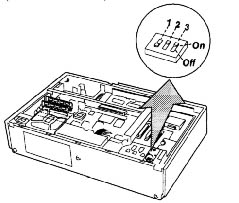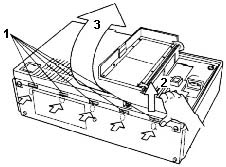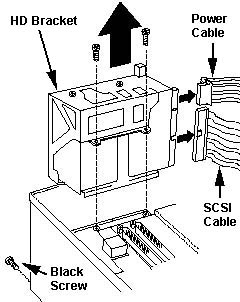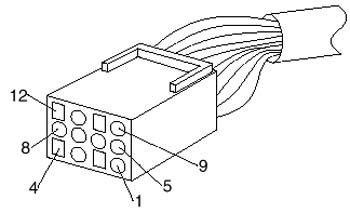|
Remove Hard Drive Set SCSI ID External Storage Device Port External Storage Device Cable Cable Source Power Supply Checkout Power Supply Fan (Remove/Install) Remove power On Password Symptom to FRU Index Opening the Case
NOTE: There are two additional catches,
one to each side of the carrying handle.When you lift up the rear cover,
it pivots on them.
Hard Drive Removal
Set SCSI ID 
Switch Position SCSI ID 1 2 3 ID6 Off On On ID5 On Off On ID4 Off Off On ID3 On On Off ID2 Off On Off ID1 On Off Off ID0 Off Off Off
External Storage Device Port The external storage device port is the equivalent of the B drive internal diskette port, as found in the PS/2 Model 70. This permits attachment of externally powered devices like the IBM 4869 External Diskette Drive Model 001 and some other equipment manufacturers' backup devices. External
Storage Device Cable
External Storage
Device Cable Source
The system I am using sometimes refuses to start after power-on without any display or beep symptom. After several power on-off eventually it starts. Any idea??? From Peter
On various occasions I saw failing mainboards. They refused to come on - and I don't know why. They simply died from one day to the next and could only be replaced. Back in the "good old days" with full IBM support and machines under warranty that was no big problem. Today things look different. If cleaning the power supply doesn't help - and if removing all adapters and testing with the bare sysboard doesn't change the misbehaviour: suspect the mainboard to be damaged and look for a replacement. Under rare circumstances a poorly seated card-riserboard caused trouble.
Have the small two-slot riserboard removed, clean the contacts and spray
a good amount of TV-tuner cleaner in the board connector. Let it dry for
10 minutes and use a piece of stiff card pushed into the connector with
one edge and move it up / down the connector. Then spray the connector
once again and let it dry for an hour. You might also repeat these steps
on the two MCA slots on the
Some older units also developed a sort of "creeping short" along the FDD cable where the FDD cable enters the "flip out" FDD bay. There was an ECA for the FDD cable from IBM for the earlier models, where FDD cables broke, shortened DC-voltages to GND or FDD signals and caused a dead systemboard. (Few only - IBM fixed it in an early stage). Another potential problem has been reported with the memory modules. The system takes only 1 and 2MB modules anyway, but certain 2MB modules installed on the sysboard connectors with double sided 10 chips layout (20 chips total - 2 x 8 data + 2 x 2 parity - 16 bigger and 4 smaller chips) caused overload of the memory driver lines. This usually resulted in either a 200-something memory error -or- a machine failing to come up at all. I take from the 16MB you'd mentioned that the upper slot contains a memory card (the lower is too short anyway). So you should probably check the card connector as described further above and check if you cannot use memory modules with lower amount of chips. Usually the memory installed on cards causes a 200-series memory error in first place before dumping the machine to total darkness - but you never know. I have several P70 in my collection and all of these run with double-sided
2MB chips ... but I had a customer machine in '93 or so, which didn't.
We used later 2MB/70ns 9-chip modules "hardware-recoded" (with soldering)
to 2MB / 85ns and the system worked like a charm.
Power Systems Checkout
Pin positions 6 and 7 are unpopulated.
System Unit Fan It is a Matsushita Panaflow DC Brushless fan, Model FBK-09A12L, DC 12v 0.1A Remove/Install System Fan
System Unit Fan:
Remove Power-on Password To remove an active, unknown, power-on password do the following. 1. Power-off the computer and unplug the power cord. 2. Remove the system-unit cover. 3. Short the two pins of JP1 together. With the pins shorted, power-on the computer. This erases the power-on
password. Remove the short after POST is finished.
Symptom-to-FRU Index
|


